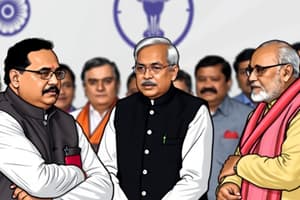Podcast
Questions and Answers
What major legislation did President Obama advocate for to improve health insurance accessibility?
What major legislation did President Obama advocate for to improve health insurance accessibility?
- Affordable Care Act (correct)
- Civil Rights Act
- Health Insurance Reform Act
- Voting Rights Act
The Supreme Court upheld the independent state legislature theory in 2023.
The Supreme Court upheld the independent state legislature theory in 2023.
False (B)
What action did Georgia take in 2021 regarding voting regulations?
What action did Georgia take in 2021 regarding voting regulations?
Georgia passed a law making voter ID requirements stricter and limited options to vote outside of Election Day.
In 2013, the Supreme Court struck down a key provision of the _______.
In 2013, the Supreme Court struck down a key provision of the _______.
Match the following cases or laws with their descriptions:
Match the following cases or laws with their descriptions:
What is an advantage of federalism related to policy goals?
What is an advantage of federalism related to policy goals?
Most political careers in the U.S. begin at the national level.
Most political careers in the U.S. begin at the national level.
How many total elected offices are there at the federal, state, and local levels in the U.S.?
How many total elected offices are there at the federal, state, and local levels in the U.S.?
Elected representatives in municipal and township governments account for a little more than half of all elected __________ in the United States.
Elected representatives in municipal and township governments account for a little more than half of all elected __________ in the United States.
Match the following government bodies with their respective number of elected officials:
Match the following government bodies with their respective number of elected officials:
Which of the following is NOT a benefit of federalism, as discussed in the text?
Which of the following is NOT a benefit of federalism, as discussed in the text?
The text argues that states cannot experiment with new policies without risking national consequences.
The text argues that states cannot experiment with new policies without risking national consequences.
What does the text refer to as a 'laboratory' in the context of policy innovation?
What does the text refer to as a 'laboratory' in the context of policy innovation?
The text cites ______ as an example of a state that has led the way in establishing environmental standards.
The text cites ______ as an example of a state that has led the way in establishing environmental standards.
Match the following concepts with their descriptions:
Match the following concepts with their descriptions:
Which of these examples is NOT mentioned in the text as an area where states have served as models for other states?
Which of these examples is NOT mentioned in the text as an area where states have served as models for other states?
The text suggests that federalism has been successful in eliminating all instances of conflict between state and national governments.
The text suggests that federalism has been successful in eliminating all instances of conflict between state and national governments.
How did state policies influence the development of national policies?
How did state policies influence the development of national policies?
Which level of government has the most elected officials?
Which level of government has the most elected officials?
In 2018, more U.S. adults trusted Congress than their local governments.
In 2018, more U.S. adults trusted Congress than their local governments.
What is the total number of elected bodies and elected officials at all levels of government combined?
What is the total number of elected bodies and elected officials at all levels of government combined?
The number of municipal governments in the U.S. is __________.
The number of municipal governments in the U.S. is __________.
What is a drawback of federalism?
What is a drawback of federalism?
Which state had the highest median household income in 2017?
Which state had the highest median household income in 2017?
Match the type of government with the number of elected officials:
Match the type of government with the number of elected officials:
There are 1,036 statewide offices in the U.S.
There are 1,036 statewide offices in the U.S.
Race-to-the-bottom dynamics refer to states raising taxes to attract businesses.
Race-to-the-bottom dynamics refer to states raising taxes to attract businesses.
What percentage of U.S. adults trusted their state governments in 2018?
What percentage of U.S. adults trusted their state governments in 2018?
What was the median household income in West Virginia in 2017?
What was the median household income in West Virginia in 2017?
In 2016, New York spent _____ per student for elementary and secondary education.
In 2016, New York spent _____ per student for elementary and secondary education.
Match the following states with their education spending per student:
Match the following states with their education spending per student:
How do proponents of social justice view federalism in relation to economic disparities?
How do proponents of social justice view federalism in relation to economic disparities?
As of March 2021, most states have opted to expand Medicaid as per the Affordable Care Act.
As of March 2021, most states have opted to expand Medicaid as per the Affordable Care Act.
What major historical event led to federal responses being blocked by the Supreme Court during President Roosevelt's administration?
What major historical event led to federal responses being blocked by the Supreme Court during President Roosevelt's administration?
Flashcards
Federalism
Federalism
A system of government where power is shared between a central authority (national government) and regional authorities (states).
Policy Innovation
Policy Innovation
States can experiment with new laws and policies, providing lessons for other states and the federal government.
Accommodating Diversity
Accommodating Diversity
Federalism allows for a greater variety of viewpoints and needs to be considered, making it easier to find common ground.
Increased Participation
Increased Participation
Local governments have the power to address specific community needs, making citizens feel more connected to their government.
Signup and view all the flashcards
Conflict
Conflict
The potential for conflict between national and state governments when they disagree on issues.
Signup and view all the flashcards
Inequality
Inequality
Unequal distribution of resources and power between states, leading to disparities in services and opportunities.
Signup and view all the flashcards
Implementation Challenges
Implementation Challenges
The difficulty of enacting consistent policies across the country due to diverse state laws and regulations.
Signup and view all the flashcards
Overreach
Overreach
The possibility of one level of government overstepping its authority and encroaching on the powers of another.
Signup and view all the flashcards
Federalism and Policy Goals
Federalism and Policy Goals
The ability of different levels of government (federal, state, and local) to work together to achieve policy goals. If one level fails, another level can try to address the issue.
Signup and view all the flashcards
Federalism in the US
Federalism in the US
The system of government in the United States where power is divided between the national government and state governments. Each level has its own responsibilities and authority.
Signup and view all the flashcards
Political Participation in Federalism
Political Participation in Federalism
The practice of actively participating in shaping public policy by individuals, groups, and social movements. They can influence government actions at different levels through voting, organizing, and lobbying.
Signup and view all the flashcards
Elected Officials in US
Elected Officials in US
The large number of elected officials in the US, exceeding 500,000. This system provides opportunities for involvement at various levels of government.
Signup and view all the flashcards
Political Career Progression
Political Career Progression
The common path for political careers in the US often starts at the local level and progresses towards higher levels. Many politicians first gain experience in their communities before seeking higher office.
Signup and view all the flashcards
State and Local Autonomy
State and Local Autonomy
The power of state and local governments to address issues based on their unique needs and preferences.
Signup and view all the flashcards
Uniform Policies
Uniform Policies
Policies that are consistent across all states, often enforced by the federal government.
Signup and view all the flashcards
Checks and Balances
Checks and Balances
The process where different branches of government (e.g., legislative, executive, judicial) limit each other's power.
Signup and view all the flashcards
State Policy Diversity
State Policy Diversity
Differences in how states approach issues like abortion, alcohol, gun control, and welfare benefits based on their own values and priorities.
Signup and view all the flashcards
Federal Preemption
Federal Preemption
When the federal government prevents states from implementing policies that differ from national standards.
Signup and view all the flashcards
Potential for Conflict in Federalism
Potential for Conflict in Federalism
The potential for conflict between different levels of government (federal, state, local) when they have overlapping powers.
Signup and view all the flashcards
Advantages of Federalism
Advantages of Federalism
Benefits of federalism such as addressing local issues, diverse policies, and a system of checks and balances.
Signup and view all the flashcards
Supreme Court's Decision on Voting Rights Act
Supreme Court's Decision on Voting Rights Act
The legal challenge to a key provision of the Voting Rights Act of 1965 that allowed federal oversight of nine states with a history of racial discrimination in voting. The Supreme Court struck down this provision in 2013, effectively reducing federal involvement in ensuring fair elections.
Signup and view all the flashcards
Independent State Legislature Theory
Independent State Legislature Theory
The theory that state legislatures have unrestricted power to set election rules, without any federal or judicial oversight. This theory was rejected by the Supreme Court in 2023, confirming that state election laws are subject to judicial review.
Signup and view all the flashcards
Affordable Care Act's Challenges
Affordable Care Act's Challenges
Federal law known as the Affordable Care Act aimed at making health insurance accessible to more Americans. This law faced numerous challenges - both political and legal - immediately after its enactment.
Signup and view all the flashcards
States as Policy Laboratories
States as Policy Laboratories
A concept that state governments can experiment with new laws and policies without direct interference from the federal government. This has implications for the evolution of policies on issues like healthcare and voting laws.
Signup and view all the flashcards
Moore v. Harper and Voting Laws
Moore v. Harper and Voting Laws
The impact of the Supreme Court ruling in Moore v. Harper, stating that state legislatures are not entirely free to create voting regulations without judicial review. It maintains the federal government's role in preventing unfair or discriminatory voting practices.
Signup and view all the flashcards
Race-to-the-bottom dynamics
Race-to-the-bottom dynamics
States competing to attract businesses by offering lower taxes and regulations, often at the expense of worker safety and social programs.
Signup and view all the flashcards
Economic disparities across states
Economic disparities across states
The idea that differences in state resources and policies can lead to unequal opportunities and outcomes for citizens.
Signup and view all the flashcards
Difficulty of national action
Difficulty of national action
The difficulty of enacting consistent national policies due to varying state laws and regulations.
Signup and view all the flashcards
States competing for businesses
States competing for businesses
States using lower taxes and regulations to attract businesses, often at the cost of worker protections and social welfare.
Signup and view all the flashcards
Federalism obstructing national efforts
Federalism obstructing national efforts
The potential for states to undermine national policy efforts by pursuing their own agendas, especially in areas like healthcare and education.
Signup and view all the flashcards
Social costs of state competition
Social costs of state competition
States reducing taxes and regulations to attract businesses, which can lead to lower wages, reduced worker protections, and underfunded social programs.
Signup and view all the flashcards
Federal checks and balances hindering national action
Federal checks and balances hindering national action
The Supreme Court striking down President Roosevelt's efforts to address the Great Depression, highlighting the challenges of implementing nationwide policy.
Signup and view all the flashcards
States as policy innovators
States as policy innovators
The idea that states can experiment with different policies, potentially generating lessons and best practices for other states and the federal government.
Signup and view all the flashcardsStudy Notes
Learning Objectives
- Discuss advantages of federalism
- Explain disadvantages of federalism
Benefits of Federalism
- Promotes policy innovation: States can experiment with new policies, like those in child labor laws and women's suffrage, without affecting the entire nation. States can act as "laboratories" for ideas, allowing successful innovations to potentially spread.
- Facilitates political participation: Provides more avenues for citizens to participate in policy-making at the state and local levels leading to diverse policy outcomes.
- Accommodates diverse opinions: The system allows for different viewpoints and opinions in states, avoiding a one-size-fits-all national approach.
- Example of Innovation: California's environmental policies have served as a model for other states. Health insurance exchanges in Connecticut, Kentucky, Rhode Island, and Washington have also influenced others.
Disadvantages of Federalism
- Economic disparities: Significant differences in income and funding between states affects citizens' well-being and access to services like education. States compete with each other to attract business by lowering regulations and taxes, potentially impacting worker safety and pay.
- Race-to-the-bottom dynamics: States often compete with each other to offer lower taxes and regulations to attract businesses. This can lead to a decline in overall standards for labor, environmental protection, etc.
- Difficulty in addressing national issues: A lack of consistent policies across states can hinder the effective solutions to national problems. The system can make it challenging for the federal government to pass comprehensive laws, such as those regarding voting rights.
- Political gridlock: The complex system of checks and balances can prevent national responses to significant problems. The system can lead to political gridlock, hindering comprehensive national policy solutions.
- Example: The Supreme Court's decision in 2013 to nullify a part of the Voting Rights Act allowed states to make changes to voting laws. California and other states previously faced federal oversight in regards to voting regulations.
Federalism and Political Office
- Many elected offices exist at the federal, state, and local levels.
- Subnational level (state and local) offices are more accessible for individuals pursuing political careers.
Studying That Suits You
Use AI to generate personalized quizzes and flashcards to suit your learning preferences.




